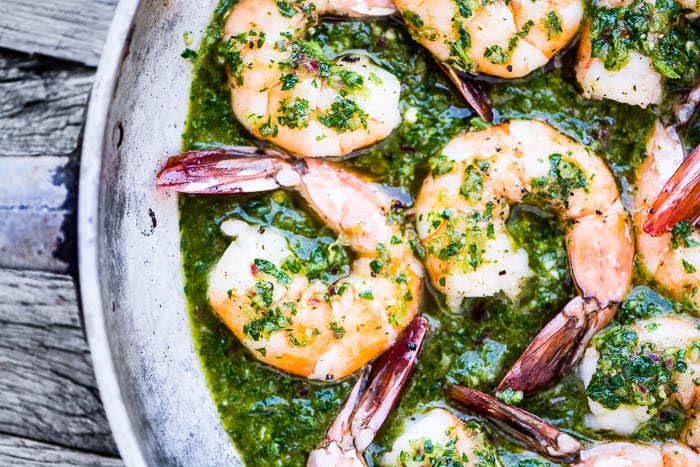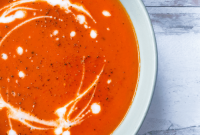Prepare to embark on a culinary journey that harmonizes the vibrant flavors of chimichurri sauce with the succulent taste of shrimp and the refreshing tang of tomatoes. This delectable dish, rooted in the traditions of Argentina and enhanced with contemporary culinary flair, promises an explosion of flavors that will tantalize your taste buds.
As we delve into the world of Chimichurri Shrimp with Tomatoes, we’ll explore the cultural significance of chimichurri sauce, uncover the intricacies of its preparation, and discover the diverse variations and adaptations that make this dish a versatile culinary masterpiece.
Introduction to Chimichurri Shrimp with Tomatoes
Chimichurri, a vibrant and flavorful sauce originating in Argentina and Uruguay, has become a beloved condiment worldwide. Its bold blend of fresh herbs, tangy vinegar, and zesty spices brings life to grilled meats and vegetables.
Chimichurri shrimp with tomatoes combines the delightful flavors of chimichurri with succulent shrimp and juicy tomatoes, creating a dish that is both savory and refreshing. This culinary creation showcases the vibrant colors and aromas of the Mediterranean region, making it a perfect choice for a light and flavorful meal.
Components and Flavors
The essence of chimichurri shrimp with tomatoes lies in its carefully selected ingredients. Fresh parsley, cilantro, and oregano provide a herbaceous foundation, while garlic, red pepper flakes, and cumin add a layer of warmth and depth. The acidity of red wine vinegar balances the richness of olive oil, creating a harmonious and tangy dressing.
Succulent shrimp, cooked to perfection, absorbs the vibrant flavors of the chimichurri sauce. Juicy tomatoes, bursting with natural sweetness, complement the briny notes of the shrimp, adding a refreshing and vibrant dimension to the dish.
Cooking Process and Techniques
The preparation of chimichurri shrimp with tomatoes is a simple yet rewarding process. The chimichurri sauce is made by finely chopping the herbs, garlic, and spices, then whisking them together with olive oil and red wine vinegar. The shrimp are cooked quickly in a hot skillet, ensuring they remain tender and juicy.
Once the shrimp are cooked, they are tossed with the chimichurri sauce and served over a bed of ripe tomatoes. The dish can be garnished with additional herbs, such as cilantro or parsley, for an extra burst of freshness.
Ingredients and Preparation
Chimichurri shrimp with tomatoes is a delectable dish that combines the vibrant flavors of chimichurri sauce with the succulence of shrimp and the freshness of tomatoes. Let’s explore the ingredients and the step-by-step process of preparing this tantalizing dish.
The essential ingredients for chimichurri shrimp with tomatoes include:
- Shrimp: Large, succulent shrimp, preferably deveined and peeled, are the stars of this dish.
- Tomatoes: Ripe, juicy tomatoes, diced into small pieces, add a burst of freshness and acidity to the dish.
- Chimichurri Sauce: This vibrant sauce is the heart of the dish. It typically consists of fresh herbs like parsley, cilantro, and oregano, minced garlic, olive oil, red wine vinegar, and spices like cumin and paprika.
- Olive Oil: Extra virgin olive oil is used to enhance the flavors of the chimichurri sauce and to cook the shrimp.
- Garlic: Minced garlic adds a savory and aromatic touch to the dish.
- Seasonings: Salt, pepper, and paprika are used to enhance the overall flavor profile.
The preparation of chimichurri shrimp with tomatoes involves two main steps: making the chimichurri sauce and cooking the shrimp.
Making the Chimichurri Sauce:
In a food processor or blender, combine all the ingredients for the chimichurri sauce, including parsley, cilantro, oregano, garlic, olive oil, red wine vinegar, cumin, paprika, salt, and pepper. Pulse until the mixture is well combined but still has a slightly chunky texture.
Cooking the Shrimp:
- In a large skillet, heat a generous amount of olive oil over medium heat.
- Once the oil is shimmering, add the shrimp and cook for 2-3 minutes per side, or until they turn opaque and pink.
- Add the diced tomatoes and cook for an additional 2-3 minutes, stirring occasionally.
- Pour the chimichurri sauce over the shrimp and tomatoes, and stir to coat evenly.
- Reduce the heat to low and simmer for 5-7 minutes, or until the sauce has thickened slightly.
- Serve immediately with rice, pasta, or your favorite side dish.
Variations and Adaptations
Chimichurri shrimp with tomatoes is a versatile dish that can be adapted to suit various preferences and dietary restrictions. Let’s explore some creative variations and substitutions that can enhance the dish’s flavors and cater to different needs.
Alternative Shrimp Types
While medium shrimp is commonly used in this recipe, feel free to experiment with different sizes and varieties of shrimp. Larger shrimp, such as jumbo or colossal, can provide a more substantial bite, while smaller shrimp, such as cocktail or salad shrimp, can add a delicate texture to the dish.
Alternatively, you can use a mix of different sizes for a varied texture experience.
Dietary Restrictions and Substitutions
For individuals with shellfish allergies or those following a vegan diet, there are several options to enjoy a similar flavor profile. Consider using firm-textured tofu or tempeh as a plant-based alternative to shrimp. Additionally, you can substitute the shrimp with grilled or roasted vegetables like zucchini, bell peppers, or mushrooms for a hearty vegetarian option.
Creative Variations
To add a unique twist to the classic chimichurri shrimp with tomatoes, try incorporating different vegetables or herbs. Roasted red peppers, sautéed spinach, or grilled corn kernels can add vibrant colors and textures to the dish. Experiment with various herbs like cilantro, oregano, or basil to create a flavorful and aromatic chimichurri sauce.
Serving Suggestions and Presentation

Chimichurri shrimp with tomatoes is a versatile dish that can be served in a variety of ways. Here are some ideas for attractive presentation techniques, appropriate side dishes, and garnishes to enhance the visual appeal of the dish:
Presentation Techniques
- Arrange the shrimp in a single layer on a serving platter or individual plates. Drizzle with chimichurri sauce and sprinkle with chopped parsley or cilantro.
- For a more elegant presentation, skewer the shrimp and grill them. Serve the skewers with a side of chimichurri sauce for dipping.
- Create a vibrant and colorful presentation by adding roasted vegetables such as bell peppers, zucchini, and onions to the dish.
Side Dishes
- Serve the chimichurri shrimp with a side of rice, quinoa, or pasta. These grains provide a neutral base that allows the flavors of the shrimp and chimichurri to shine through.
- Grilled vegetables such as zucchini, bell peppers, and onions are a healthy and flavorful accompaniment to the shrimp.
- A fresh salad with mixed greens, tomatoes, cucumbers, and a light vinaigrette dressing is a refreshing side dish that complements the richness of the shrimp.
Garnishes and Finishing Touches
- Sprinkle chopped fresh herbs such as parsley, cilantro, or chives over the shrimp before serving. This adds a pop of color and a burst of flavor.
- Garnish the dish with lemon wedges or lime wedges. The citrusy flavor of the lemons or limes pairs well with the chimichurri sauce.
- Drizzle a small amount of olive oil over the shrimp before serving. This adds a glossy sheen and enhances the flavor of the dish.
Health Benefits and Nutritional Information
Chimichurri shrimp with tomatoes offers a plethora of nutritional benefits. It is a rich source of protein, essential vitamins, minerals, and antioxidants. Consuming this dish can contribute to overall well-being and provide various health advantages.
Nutritional Value
- Protein: Chimichurri shrimp is a substantial source of protein, providing essential amino acids necessary for building and repairing tissues, maintaining muscle mass, and supporting various bodily functions.
- Omega-3 Fatty Acids: The shrimp used in this dish contains heart-healthy omega-3 fatty acids, which have been associated with reduced inflammation, improved cardiovascular health, and cognitive function.
- Vitamins: Chimichurri shrimp with tomatoes is a good source of vitamins A, C, and E. Vitamin A supports vision and immune function, vitamin C aids in collagen production and antioxidant protection, and vitamin E serves as an antioxidant, protecting cells from damage.
- Minerals: This dish also provides essential minerals such as iron, calcium, and potassium. Iron is vital for red blood cell production and oxygen transport, calcium is crucial for bone health, and potassium plays a role in regulating blood pressure and nerve function.
- Antioxidants: The combination of shrimp, tomatoes, and herbs in chimichurri sauce provides a rich source of antioxidants. These compounds help protect cells from damage caused by free radicals, reducing the risk of chronic diseases.
Health Benefits
Consuming chimichurri shrimp with tomatoes regularly can offer several health benefits, including:
- Improved Heart Health: The omega-3 fatty acids and antioxidants in this dish contribute to better heart health by reducing inflammation, lowering blood pressure, and improving cholesterol levels.
- Enhanced Immune Function: The presence of vitamins A, C, and E, along with antioxidants, supports a robust immune system, helping to ward off infections and illnesses.
- Stronger Bones and Muscles: The protein, calcium, and vitamin D in this dish promote healthy bones and muscles, reducing the risk of osteoporosis and supporting muscle strength and mobility.
- Reduced Risk of Chronic Diseases: The antioxidants in chimichurri shrimp with tomatoes help combat oxidative stress and protect against chronic diseases, including certain types of cancer and neurodegenerative disorders.
Tips for a Healthier Dish
To make chimichurri shrimp with tomatoes even healthier, consider the following tips:
- Use Whole-Wheat or Brown Rice: Instead of white rice, opt for whole-wheat or brown rice, which are higher in fiber and nutrients.
- Reduce Oil: Be mindful of the amount of oil used in cooking the shrimp and vegetables. Use a nonstick pan or cooking spray to minimize oil consumption.
- Add More Vegetables: Increase the vegetable content by incorporating a variety of colorful vegetables, such as bell peppers, zucchini, or broccoli, to boost the nutritional value of the dish.
- Use Low-Sodium Soy Sauce: If using soy sauce in the chimichurri sauce, choose a low-sodium variety to reduce sodium intake.
- Limit Processed Ingredients: Avoid using pre-packaged or processed ingredients, such as store-bought chimichurri sauce or frozen shrimp, to minimize unhealthy additives and preservatives.
Cultural and Regional Influences
Chimichurri shrimp with tomatoes is a dish that has been embraced by various cultures and regions, each leaving its unique mark on the recipe. Its roots can be traced back to Argentina and Uruguay, where it is considered a national dish.
The dish has since spread to other parts of South America, as well as to Europe and North America, where it has been adapted to local tastes and preferences.
Evolution and Adaptation
Over time, chimichurri shrimp with tomatoes has undergone several transformations, reflecting the diverse culinary traditions of the regions where it is enjoyed. In Argentina and Uruguay, the dish is typically prepared with fresh, plump shrimp, juicy tomatoes, and a flavorful chimichurri sauce made from parsley, garlic, olive oil, and red wine vinegar.
As the dish traveled to other countries, it encountered new ingredients and cooking techniques, resulting in variations that showcase the creativity and resourcefulness of local chefs.
Cultural Impact
Chimichurri shrimp with tomatoes has become a symbol of culinary fusion, bridging cultures and bringing people together. The dish has been featured in festivals, cooking competitions, and restaurant menus worldwide, gaining recognition for its vibrant flavors and versatility. Its popularity extends beyond its traditional origins, as it continues to inspire chefs and home cooks alike to experiment with different ingredients and cooking methods, creating unique interpretations of this beloved dish.
Tips and Troubleshooting

Achieving success with chimichurri shrimp with tomatoes requires careful attention to detail and proper technique. Here are some helpful tips to ensure a delicious and enjoyable dish:
Choose fresh ingredients: The quality of your ingredients greatly impacts the final dish. Use the freshest shrimp, tomatoes, and herbs for the best flavor and texture.
Marinate the shrimp: Marinating the shrimp in the chimichurri sauce not only adds flavor but also tenderizes the shrimp. Allow the shrimp to marinate for at least 30 minutes, or up to overnight.
Cook the shrimp properly: Overcooking the shrimp will make them tough and rubbery. Cook the shrimp until they are just opaque and pink in the center, about 2-3 minutes per side.
Use a hot skillet: A hot skillet will help sear the shrimp and create a nice caramelized crust. Make sure the skillet is hot before adding the shrimp.
Don’t overcrowd the skillet: Overcrowding the skillet will prevent the shrimp from cooking evenly. Cook the shrimp in batches if necessary.
Season the tomatoes: Season the tomatoes with salt, pepper, and a touch of sugar to enhance their flavor.
Serve immediately: Chimichurri shrimp with tomatoes is best served immediately after cooking. The shrimp will become tough if they sit for too long.
Common Challenges and Solutions
- The shrimp are overcooked:
If the shrimp are overcooked, they will be tough and rubbery. Be careful not to overcook the shrimp. Cook them until they are just opaque and pink in the center. - The tomatoes are too acidic:
If the tomatoes are too acidic, you can add a touch of sugar to balance out the flavor. You can also use a milder variety of tomatoes, such as cherry tomatoes. - The dish is too spicy:
If the dish is too spicy, you can reduce the amount of chili peppers in the chimichurri sauce. You can also add a dollop of sour cream or yogurt to cool down the heat. - The dish is bland:
If the dish is bland, you can add more salt, pepper, or chili peppers to taste. You can also add a squeeze of lime juice to brighten up the flavors.
Last Word

Our exploration of Chimichurri Shrimp with Tomatoes has unveiled a dish that embodies culinary artistry and cultural heritage. From its vibrant flavors to its versatility and health benefits, this dish stands as a testament to the power of culinary fusion and the endless possibilities that await those willing to explore the world of flavors.
FAQs
What is the origin of chimichurri sauce?
The exact origin of chimichurri sauce is shrouded in mystery, with competing claims from Argentina and Uruguay. Regardless of its birthplace, this flavorful sauce has become a beloved condiment in both countries and beyond.
Can I use different types of shrimp for this dish?
Absolutely! Feel free to experiment with various shrimp varieties such as tiger shrimp, jumbo shrimp, or even prawns. Each type offers a unique texture and flavor profile that can enhance the dish in its own way.
Are there any healthy alternatives to using butter in the chimichurri sauce?
Certainly! You can substitute butter with healthier options like olive oil or avocado oil. These alternatives provide a lighter and more heart-friendly twist to the sauce while preserving its delectable flavor.
How can I make the dish spicier?
If you crave a bit of heat, feel free to add a pinch of cayenne pepper or a dash of chili flakes to the chimichurri sauce. This fiery touch will elevate the dish’s flavor profile, adding an extra layer of excitement.



